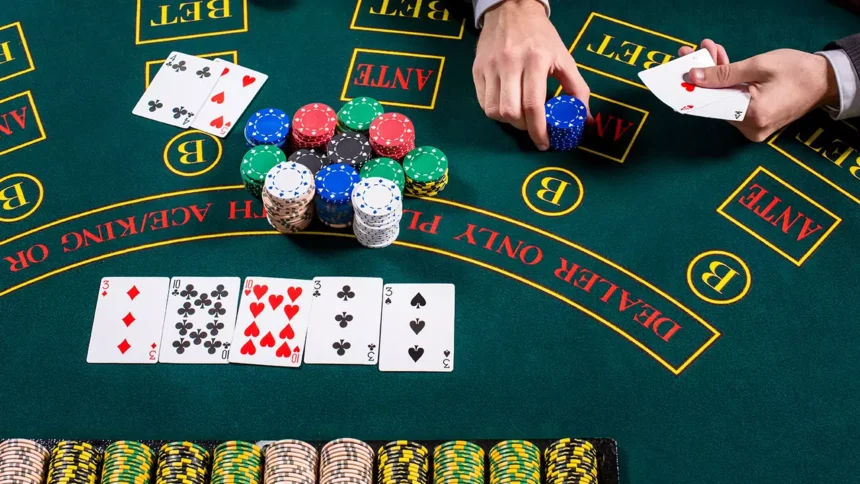Whether you’re an absolute beginner or already a big poker fan, it’s always a good idea to brush up on the rules. There are numerous variants of this popular card game, but you only need to know one or two of these before you can start playing online.
Difference between playing poker in a casino and online
Playing poker in a real casino is similar to playing online. The table set-up is the same as a virtual table, but the dealer is, of course, a real person in casinos. One notable difference you’ll notice is the speed at which the game is played. Poker in a land casino is played at a much slower pace, and you can only play at one table at a time. As a result, you’ll end up playing fewer hands.
Another significant difference is that you’re able to see the other players – something you can use to your advantage. By keeping an eye on their body language and playing style, you can try to figure out their next move or when they’re bluffing. Poker is one of the numerous casino games that has made a dominant presence online. There are various other casino games as well that offer the same level of excitement.
Now that we have dealt with the distinction between offline and online casinos, let us delve into how to play poker and its basic rules.
Poker Guide
Here’s a step-by step guide to play poker.
STEP 1- Place your bets
Before the cards are dealt, players will place their bets. These can include ante bets, where all players put in an equal amount of money, and blinds, where the player immediately to the left of the dealer places a small bet and the player to the left of them places a larger one.
Players then receive two hole (face down) cards each. At this point, players must decide if they’re going to check (decline the opportunity to start the betting), bet/call any bets (match another player’s bet), or fold if they have a weak hand. Each time a player decides to check, the opportunity to bet or check is passed on clockwise to the next player. Once a player makes the first bet, all remaining players must call, to match that amount.
STEP 2- The community cards
Once betting has concluded, the flop (three face up cards) is dealt. Players can now get a better idea of their hand strength, and another round of betting takes place.
STEP 3- Time for the turn
Next, the turn (a fourth face up card) is dealt and can be used by players to build a better hand. Bear in mind that a hand consists of only five cards. This then is followed by another round of betting.
STEP 4- Hands Are Finalized
The river (a fifth face up card) is dealt, and players who are still in can see the actual strength of their hand. Before the showdown, it’s time for one final round of betting.
STEP 5- The Winner is revealed
Now it’s time for the showdown, when players reveal their poker hands to see who has won the pot. A kicker, the highest card, may be used to break ties.
Winning Poker Hands
Here are the hand ranks, from best to worst.
Straight Flush – This is the highest possible hand. A straight flush consists of five cards of the same suit in sequence, such as 10, 9, 8, 7, 6 of hearts. The highest-ranking straight flush is the A, K, Q, J, and 10 of one suit, also called a royal flush or a royal straight flush. In order to make a straight flush, at least three of the community cards have to be of the same suit.
Four of a Kind – This is the next highest hand, and it ranks just below a straight flush. An example is four aces or four 3s. It does not matter what the fifth, unmatched card is. In order to make four of a kind, the board has to pair.
Full House – This hand is made up of three cards of one rank and two cards of another rank, such as three 8s and two 4s, or three aces and two 6s. Again, in order to make a full house, the board has to pair.
Flush – Five cards, all of the same suit, but not all in sequence, is a flush. An example is Q, 10, 7, 6, and 2 of clubs. In order to make a flush, you need at least three community cards to be of the same suit (assuming both your starting hand cards are of the same suit as the three on the board). If you only need one more suited card to make a flush after the flop, you have a 35% chance of making a flush by the river.
Straight – Five cards in sequence, but not all of the same suit, is a straight. An example is 9♥, 8♣, 7♠, 6♦, 5♥. In order to make a straight, three of the community cards have to be within two ranks of each other.
Three of a Kind – This combination contains three cards of the same rank, and the other two cards each of a different rank, such as three jacks, a seven, and a four. In order to make three of a kind, you need a pocket pair or you need the board to pair with one of your cards. When you have three of a kind, your odds of making a full house by the river are 33%.
Two Pairs – This hand contains a pair of one rank and another pair of a different rank, plus any fifth card of a different rank, such as Q, Q, 7, 7, 4. When you have two pair, the chances of making a full house by the river are 17%.
One Pair – This frequent combination contains just one pair with the other three cards being of different rank. An example is 10, 10, K, 4, 3. This is the most common showdown hand because even if you don’t start with a pocket pair, there’s a ~33% chance of making a pair on the flop.
High Card – This very common hand contains “nothing.” None of the five cards pair up, nor are all five cards of the same suit or consecutive in rank. When more than one player has no pair, the hands are rated by the highest card each hand contains, so that an ace-high hand beats a king-high hand, and so on. A high card showdown is usually the result of a paired board (there’s a pair in the community cards) or a missed flush or straight draw (at one point, the community cards represented a chance of making a flush or straight).
Basic Poker Rules
Once you’re familiar with how the game is played, there are still some poker rules that you should know about before you start to play for real money in an online casino. Here’re the rules you must be aware of:
Blinds- Most forms of poker have big and small blinds. These are sums of money that must be paid by two players each hand, to boost the value of each pot. This is totally normal and isn’t something you can avoid; just hope you have a good hand when it’s your turn to pay blinds.
Decks- In virtually all forms of poker, a single deck of cards is used. This is to prevent bizarre hands like 5 or 6 of a kind emerging. Measures like shuffling and burning mean that players still can’t accurately predict what cards will come out next.
Rake- When playing in a land-based casico or in an online casino, the house will take a certain percentage of the pot or the tournament buy-in to generate profits. This figure could be anywhere between 3-10% and is completely above board and difficult to avoid.
Chips- The number of chips you get when you sit down at an online poker table can vary hugely. It will depend on things like table limits and whether you’re playing at a tournament or not. Check this out in advance so you don’t end up feeling like a fish out of water.
People- How many people can play varies slightly from casino to casino. In theory, 20+ people could play at a single Texas Hold ‘Em table. In practice, most casino/online poker sites limit tables to around 10. Any more than 10 or 12 players at a table and hands simply take too long to play out.
Cards- How many cards you get, and whether they’re face up or face down, varies widely depending on the poker variant you’re playing. Make sure, before you start playing, that you understand all the rules of your chosen variant.
Also Read: Kylian Mbappe Creates History At Real Madrid























